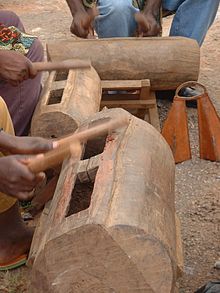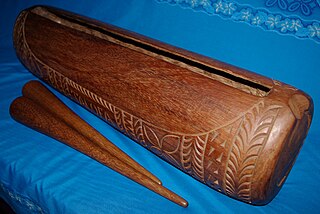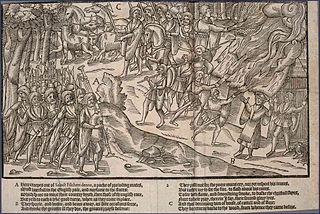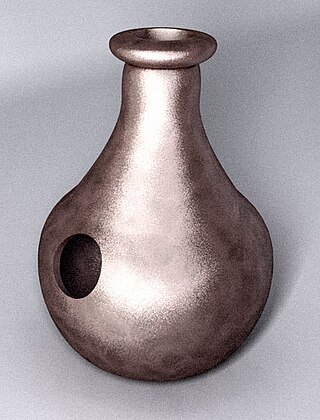
Developed and used by cultures living in forested areas, drums served as an early form of long-distance communication, and were used during ceremonial and religious functions.

Developed and used by cultures living in forested areas, drums served as an early form of long-distance communication, and were used during ceremonial and religious functions.
While the tone and articulation of this type of hourglass-shaped instrument can be finely controlled, it cannot be heard at distances beyond a gathering or market-place, and it is primarily used in ceremonial settings. Ceremonial functions could include dance, rituals, story-telling and communication of points of order.
Some of the groups of variations of the talking drum among West African ethnic groups:
In the 20th century the talking drums have become a part of popular music in West Africa, especially in the music genres of Jùjú (Nigeria) and Mbalax (Senegal).
Message drums, or more properly slit gongs, with hollow chambers and long, narrow openings that resonate when struck, are larger all-wood instruments hollowed out from a single log. Slit-log drums are common in the drum communication systems of Papua New Guinea, where they are known in Tok Pisin as garamut. [1] Variations in the thickness of the walls give varying tones when struck by the heavy wooden drum sticks. While some are simple and utilitarian, they can also be highly elaborate works of sculpture while still retaining their function.
A long slit is cut in one side of a log, then it is hollowed out through the slit, leaving lips (wooden ledges) on each side of the opening. Using a larger log enables a louder sound that can be heard over longer distances. By hollowing more under one lip and less under the other, the drum can be tuned to produce two different notes, a lower and a higher one. The drum's lips are hit with sticks, beating out rhythms of high and low notes. Small stands are often placed under each end of the drum to keep it off the ground and let it vibrate more freely.
Under ideal conditions, the sound can be understood at five to eleven kilometres (3–7 mi), [2] but interesting messages usually get relayed on by the next village. Drums used by the Bulu people of Cameroon might be heard as far away as 10 to 15 miles at night, compared to three to four during daytime. [3]
The Catuquinaru tribe of Brazil reportedly used a drum called the cambarysu to send vibrations through the ground to other cambarysus up to 1.5 km away. [4] [5] [6] Some scholars expressed skepticism about the claim that it sent vibrations through the ground (rather than the air), and about the claim that it existed. [4]
In Africa, New Guinea and tropical areas of America, people have used drum telegraphy for centuries to communicate over long distances. When European expeditions came into the jungles to explore, they were surprised to find that people already knew they were coming and what their intentions were. By repeating a message in turn from one nearby location to another, African drummers can transmit that message a total distance of 100 miles in about an hour. [7]
Among the famous communication drums are the drums of West Africa (see talking drum). From regions known today as Nigeria and Ghana they spread across West Africa, and to the America and the Caribbean during the slave trade. There they were banned because they were being used by the slaves to communicate over long distances in a code unknown to their enslavers. [8]
Talking drums were also used in East Africa and are described by Andreus Bauer in the 'Street of Caravans', about his time as a security guard in the Wissmann Truppe for the caravan of Charles Stokes.
Two different types of traditional drum communication are found in Africa. The first type associates each idea with a particular rhythmic pattern, and the second type represents spoken utterances by mimicking their accentual profiles.[ citation needed ]
Drum communication methods are not languages in their own right, though they can be based on spoken languages. In such cases, the sounds produced are conventionalized or idiomatic signals based on speech patterns. The drummed messages are normally very stereotyped and context-dependent; speakers of true languages have the ability to form new combinations and expressions that will immediately be understood by the listener, but that is not the case in drum communication.
In Central and East Africa, drum patterns represent the stresses, syllable lengths and tone of the particular language. In tone languages, where syllables are associated with a certain tone, some words are distinguished only by their suprasegmental profile. Therefore, syllable drum languages can often transfer a message using the tonal phonemes alone.
In certain languages, the pitch of each syllable is uniquely determined in relation to adjacent syllables. In these cases, messages can be transmitted as rapid beats at the same speed as speech, as the rhythm and melody both match the equivalent spoken utterance.
Misinterpretations can occur due to the highly ambiguous nature of the communication. The ambiguity is reduced by context effects and the use of stock phrases. For example, in Jabo, most stems are monosyllabic. By using a proverb or honorary title to create an expanded version of the name of a person, animal, or object, the indistinguishable single beat of an ordinary name can be replaced with a particular rhythmic and melodic motif for each subject. In practice not all listeners understand all of the stock phrases; the drum language is understood only to the level of each person's immediate concern.

The drum is a member of the percussion group of musical instruments. In the Hornbostel-Sachs classification system, it is a membranophone. Drums consist of at least one membrane, called a drumhead or drum skin, that is stretched over a shell and struck, either directly with the player's hands, or with a percussion mallet, to produce sound. There is usually a resonant head on the underside of the drum. Other techniques have been used to cause drums to make sound, such as the thumb roll. Drums are the world's oldest and most ubiquitous musical instruments, and the basic design has remained virtually unchanged for thousands of years.

Igbo is the principal native language cluster of the Igbo people, an ancient ethnicity in the Southeastern part of Nigeria.
An interjection is a word or expression that occurs as an utterance on its own and expresses a spontaneous feeling or reaction. It is a diverse category, encompassing many different parts of speech, such as exclamations (ouch!, wow!), curses (damn!), greetings, response particles, hesitation markers, and other words. Due to its diverse nature, the category of interjections partly overlaps with a few other categories like profanities, discourse markers, and fillers. The use and linguistic discussion of interjections can be traced historically through the Greek and Latin Modistae over many centuries.

Whistled languages are linguistic systems that use whistling to emulate speech and facilitate communication between individuals.
Paralanguage, also known as vocalics, is a component of meta-communication that may modify meaning, give nuanced meaning, or convey emotion, by using techniques such as prosody, pitch, volume, intonation, etc. It is sometimes defined as relating to nonphonemic properties only. Paralanguage may be expressed consciously or unconsciously.

Ceremonial drums are membranophones and idiophonic slit drums, which are played in a ritual context cult, religious or ceremonial social occasions by indigenous peoples around the world, often accompanied by singing or chanting.
An obrom is a type of musical instrument in the percussion family, originating in Nigeria. Formed from one large piece of wood, often a log of paduc, the obrom has two recesses connected to each other by a small channel. This is why it is sometimes referred to as a slit dum. The obrom, when struck with mallets near the recesses, plays two to four tones; these are generally alternated in a repetitive beat, or played in an ostinato. It was used as an instrument for communication, transferring messages in a way similar to morse code.
In linguistics, prosody is the study of elements of speech that are not individual phonetic segments but which are properties of syllables and larger units of speech, including linguistic functions such as intonation, stress, and rhythm. Such elements are known as suprasegmentals.

A slit drum or slit gong is a hollow percussion instrument. In spite of its often being called a drum, it is not a true drum because it lacks a drumhead, the membrane stretched across the top of a true drum). It is classed instead as an idiophone in which the entire instrument vibrates, usually carved or constructed from bamboo or wood, in the form of a mostly closed hollow chamber with one or more slits in it. It is played by striking near the edge of the slit. In some designs, the slit is a single straight line; in others, the slit is used to create one or more "tongues", achieved by cutting three sides of a rectangular shape and leaving the fourth side attached. Most slit drums have one slit, though two and three slits occur. Tongues of different areas or thicknesses will produce different pitches. Slit drums are used throughout Africa, Southeast Asia, and Oceania. In Africa such drums, strategically situated for optimal acoustic transmission, have been used for long-distance communication.

The music of West Africa has a significant history, and its varied sounds reflect the wide range of influences from the area's regions and historical periods.
Kaiso is a type of music popular in Trinidad and Tobago, and other countries, especially of the Caribbean, such as Grenada, Belize, Barbados, St. Lucia and Dominica, which originated in West Africa particularly among the Efik and Ibibio people of Nigeria, and later evolved into calypso music.

The Pātē is a Samoan percussion instrument of Tahitian origin, named after the Samoan word for "beat" or "clap" "pulse". It is one of many Samoan log drum variants and is of the slit drum family, and therefore is also of the idiophone percussion family. It is made from a hollowed-out log, usually of Miro wood and produces a distinctive and loud sound. Different sizes of log drums offer different pitches and volumes, as well as striking the log drum in the middle or near the ends.

A signal instrument is a musical instrument which is not only used for music as such, but also fit to give sound signals as a form of auditive communication, usually in the open air. Signal instruments are often contrasted with melodic and diatonic or chromatic instruments. To make the message audible at a distance, percussion and brass instruments, which are generally loud, are chiefly used for this purpose. There are contemporary instruments which evolved from signal instruments, such as the natural horn evolving to the trumpet.
The oldest musical signaling instrument is the drum. Signal drums are still used in parts of Africa, although more as a kind of newspaper than military device...The African [slit] drum does not communicate by rhythm or beat, but rather by tone [relative pitch and/or timbre]...As early as 500 BCE, the Persians used kettle drums both to control cavalry formation and frighten their enemies. [In Europe,] The snare drum was the standard battlefield infantry communications device from the 1700s until well into the 1860s...Trumpets, horns, and drums were used in ancient Greek and Roman armies and navies...By the reign of Alexander the Great, trumpets and fifes...were used to control the phalanx of his army. Perhaps the earliest recorded use of specific signals via musical tones were...used by Genghis Khan's Mongol cavalry in the late twelfth and early thirteenth centuries...Trumpets are undoubtedly the longest-used military musical signal instrument.

Igbo music is the music of the Igbo people, who are indigenous to the southeastern part of Nigeria. The Igbo traditionally rely heavily on percussion instruments such as the drum and the gong, which are popular because of their innate ability to provide a diverse array of tempo, sound, and pitch. Igbo music is generally lively, upbeat, and spontaneous which creates a variety of sounds that enables the Igbo people to incorporate music into almost all the facets of their daily lives. Some very popular Igbo musical styles are Igbo highlife, Ogene, Igbo gospel.

The talking drum is an hourglass-shaped drum from West Africa, whose pitch can be regulated to mimic the tone and prosody of human speech. It has two drumheads connected by leather tension cords, which allow the player to change the pitch of the drum by scraping the cords between their arm and body.

In many parts of sub-Saharan Africa, the use of music is not limited to entertainment: it serves a purpose to the local community and helps in the conduct of daily routines. Traditional African music supplies appropriate music and dance for work and for religious ceremonies of birth, naming, rites of passage, marriage and funerals. The beats and sounds of the drum are used in communication as well as in cultural expression.
The agidigbo or ‘’’molo’’’ is a large traditional plucked lamellophone thumb piano used by the Yoruba people of Nigeria to play apala music.

A teponaztli is a type of slit drum used in central Mexico by the Aztecs and related cultures.
An Ikoro is a musical instrument created and used by the Igbo of Nigeria. It is a slit drum that is beaten with a stick or sticks and can be used in some parts of Igbo land for communicating, similar to a talking drum. Ikoro cannot be played by anyone. It is so special that any time its sound is heard people will gather at the village square. As soon as it sounds, people around assume that any of the following has happened: murder, land has been defiled, an outbreak of war, a calamity has befallen the community, etc. Any time the ikoro is heard, people gather at the village square to hear the latest developments. Ikoro also brings a sense of urgency.
Izi is an Igboid language spoken in Ebonyi state in Nigeria. It forms a dialect cluster with the closely related languages Ikwo, Ezza, and Mgbo.
Drum messages can be heard at a distance of between three to seven miles, according to Carrington 1949b: 25.